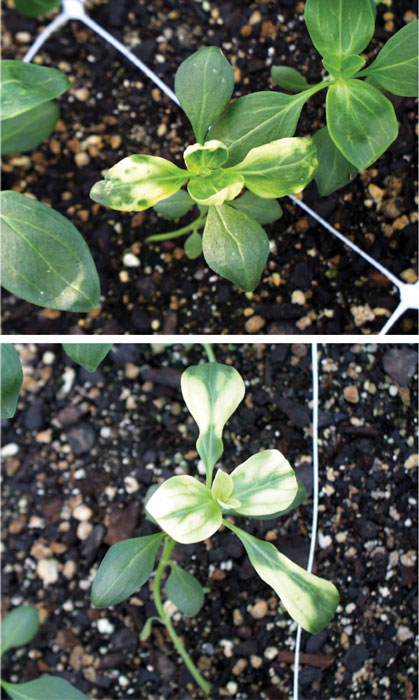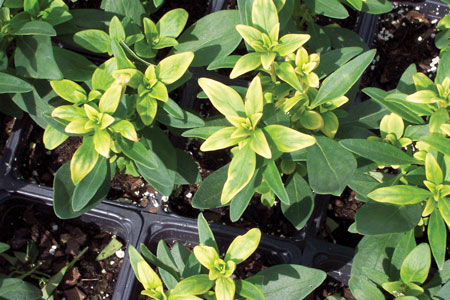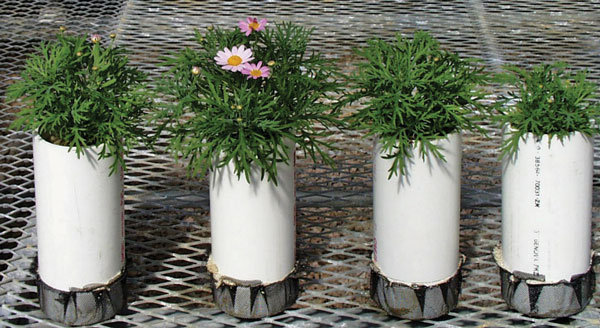1/1/2020
Form & Function
Allison Westbrook

Plants need lots of nitrogen. It’s a plant macronutrient and no wonder—it’s needed for the plant to produce proteins, nucleic acids and chlorophyll. And if you don’t have enough, you can expect to see leaf chlorosis, stunted plants and even death of older leaves.
So how to make sure your plants get the nitrogen they need? You’ve got to know which chemical forms of nitrogen plants can take up under different conditions and which sources you can use to get those chemical forms to your plants.
You may assume it depends on the type of plant you’re growing, but actually, it’s the where and when you’re growing, rather than the what. The source of nitrogen that growers choose isn’t as much for specific plants as it is for specific situations and what the desired outcome is, says Dr. Todd Cavins, Technical Services Specialist at Ball Horticultural Company.
Pictured: NH3 toxicity on cut flower snapdragons due to recent steam treatment that killed bacterium that would have converted NH4 to NO3.
The two main forms are nitrate (NO3) and ammoniacal nitrogen (NH4). Ammoniacal nitrogen has several different sources; it’s more of a generic term. The sources of nitrogen supplied via fertilizer are ammonium N (NH4-N), Urea-N, Nitrate N (NO3-N) and organic nitrogen. Each has unique properties that can have associated effects on plant growth, substrate pH and nutrient availability.
The form of nitrogen depends largely on the time of year and environment that the plants are being grown in. During cool, cloudy weather seasons, nitrate is the preferred form for most crops, as ammonium won’t convert to nitrate (the form the plants most readily uptake) in a sufficient quantity under those conditions. Also, ammonia gas can stagnate and build up in the soil, which can become toxic to the roots and plant. In warm weather, either form can be used, taking into consideration water quality and what the plant’s needs are as far as growth.
Toned vs. lush
The form of nitrogen provided also affects the type of growth. With nitrate, growth is more toned and compact, whereas with ammoniacal nitrogen, growth is softer and more lush, with bigger leaves and more cell expansion. One isn’t necessarily better than the other, it’s all up to how the plants need to be grown. If crops are behind, ammoniacal nitrogen can be used to have them fill out. If toned growth is needed, nitrate can be applied to achieve that effect. In fact, Todd shared that his strategy is to get growers to switch over to nitrate instead of using PGRs to manage growth.
This is especially important to plug growers, as they want to get the plants growing rapidly, but they need to be toned because toned growth fits into a box and ships better.
“Toned growth is usually tougher growth, so plants are more resilient to environmental factors—wind, a grower throwing a flat on the ground or herbivory from insects,” says Todd.
Effects on pH
Another concern is how the different forms of nitrogen affect the pH of the soil. Todd broke down the chemistry behind these processes:
Nitrate nitrogen is an anion, which has a negative charge. The plant wants to remain neutral, so for the root to take up the anion, the root gives off a negative charge in the form of a hydroxide ion (OH-). The anion grabs onto the H+- ion, which is acidic, and over time, this neutralizes the acidity of the soil and raises the pH.
 Pictured: Snapdragons with a feed of 20-20-20 fertilizer (high urea and NH4) during cool production
Pictured: Snapdragons with a feed of 20-20-20 fertilizer (high urea and NH4) during cool production
The opposite is true for ammoniacal nitrogen, which is a positively charged ion. To take up the positive ion, the plant root kicks out hydrogen, H+. The more hydrogen in the soil, the lower the pH. Urea, another source of ammoniacal nitrogen, converts to a salt in the soil, which also causes the plant to give off H+, which lowers the pH.
The right pH range is 5.8 to 6.2 for most crops, as this controls nutrient availability, says Todd. “So not only do we have to be concerned about our plant growth, but now if we adjust it too much one way or the other, we could get our soil pH off and that will cause lots of nutrient uptake issues, especially the micronutrients such as iron and manganese, which are some of the trickiest to deal with.”
Water quality
Water quality is also important in choosing the right source of nitrogen, mainly the alkalinity of the water, says Todd. The alkalinity can basically be thought of as “dissolved limestone” in the water and is the driver of the buffering capacity. High alkalinity can increase the pH of the media and high ammoniacal nitrogen can neutralize this effect.
 Pictured: NH4 vs. NO3 N source research trial with argyranthemum. From left to right: 100% Nitrate, 0% ammonium; 75% Nitrate, 25% ammonium; 25% Nitrate, 75% ammonium; and 0% Nitrate and 100% ammonium.
Pictured: NH4 vs. NO3 N source research trial with argyranthemum. From left to right: 100% Nitrate, 0% ammonium; 75% Nitrate, 25% ammonium; 25% Nitrate, 75% ammonium; and 0% Nitrate and 100% ammonium.
Peat moss and potting soil often have limestone added to achieve a pH of around 6. If high amounts of ammonium fertilizer are added, the pH can drop from 6 to the mid to low 5s, which can cause micronutrient toxicity. In cool, cloudy times, if ammoniacal nitrogen is used to reduce the pH, micronutrient and ammonia gas toxicity can be caused in that case as well.
Hydroponics are a special case, Todd says, in that growers have to be constantly concerned with ammonia toxicity, as there are no soil microbes for binding and gas exchange, and liquid hydroponic solutions are usually high nitrate solutions, which drive up the pH. Growers often combat this effect by adding acid to their solution to lower the pH.
Ultimately, many considerations should be made around the choice of nitrogen form: temperature, environment, water quality and pH of the soil. There’s no one-size-fits-all, but with the right information, growers can choose which form of nitrogen will give them the results they need.
Dr. Ryan Dickson, associate professor at the University of Arkansas, broke down the various sources of nitrogen:
Ammonium N (NH4-N)
• Rapidly taken up by roots and has a very strongly acidic effect on root zone pH (lowers pH)
• Too much NH4-N can cause soft, lush growth and ammonium toxicity, particularly in cool weather and low-light conditions
• Water-soluble fertilizers with a “neutral” pH effect for greenhouse crops often contain between 20% to 30% of total N as NH4-N (with the remainder as nitrate NO3-N). Ammonium can be supplied at higher concentrations in certain scenarios to counteract the basicity (raises pH) of high water alkalinity.
Urea-N
• Lowers root zone pH, but not as acidic as NH4-N
• Urea is converted to ammonium in the root zone; Excessive supply of urea can result in soft growth and toxicity, similar to NH4-N
Nitrate N (NO3-N)
• Nitrate has a basic effect on root zone pH and raises pH over time. Nitrate is a weaker base than NH4-N is an acid. Supply of NO3-N typically results in more toned and compact growth, particularly in low conditions.
Organic N
• Organic nitrogen is bound in materials such as organic fertilizers and composts. N release occurs from microbial breakdown of organic materials, providing a slow release of fertilizer N over time.
• Release of N increases at warmer temperatures and decreases at cooler temperatures
• Organic materials vary in their potential release rates and effects on plant growth GT